During the years I have researched and worked on the three-volume series of Where Did They Put the Gestapo Headquarters? (click here to see the book), I came across many stories, some of which end up as blog posts. My favorite topics include stories about the brave men and women who fought the Nazis as either bona fide resistance fighters, foreign agents, or ordinary people who did what they knew was right knowing full well that death would be their reward if caught.
I particularly enjoy sharing with you the stories of the men and women who risked capture to save the lives of children. (Read the blogs, Kindertransport and Mr. Winton [click here], The French Anne Frank [click here], and Something Must Be Done [click here].) Today’s blog is one of those remarkable stories when two people convinced others of various religious beliefs to work together to save hundreds of Jewish children from the Nazi gas chambers. (Click here to read the blog, The Children Who Survived.)
Did You Know?
Did you know that Winston Churchill is well-known for his often witty, insightful, and biting quotations? Of course you knew this, but I’ll bet you don’t know that Charles de Gaulle was no slouch in the quotation department. Here are some quotes and zingers I picked out for you from that big and loveable French general:
- “No nation has friends, only interests.” (My favorite.)
- “In order to become the master, the politician poses as the servant.”
- “Patriotism is when love of your own people comes first; nationalism, when hate for people other than your own comes first.”
- “I have come to the conclusion that politics are too serious a matter to be left to the politicians.”
- “How can you govern a country which has 246 varieties of cheese?”
- “The better I get to know men, the more I find myself loving dogs.”
- “Since a politician never believes what he says, he is surprised when others believe him.”
- “Always choose the most difficult way; there you will not meet competitors.”
And finally:
- “When I am right, I get angry. Churchill gets angry when he is wrong. We are angry at each other much of the time.”
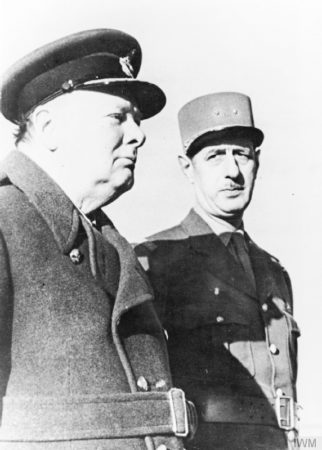
Winston Churchill and Gen. Charles de Gaulle review French soldiers during their meeting in Marrakesh, Morocco. Photo by anonymous (c. January 1944). Imperial War Museum. PD-UK Government. Wikimedia Commons.
Let’s Meet Moussa & Odette
Moussa Abadi (1910−1997) was born in Syria in the Jewish ghetto of Damascus. He learned to speak French while attending the Jewish Alliance School in Damascus and earned a scholarship to study at the Sorbonne in Paris. Moussa developed a passion for acting and the theater which carried over to his doctorate in literature (i.e., French theater in the Middle Ages). While pursuing an acting career, Moussa met Odette Rosenstock one evening in 1939 and the two of them immediately fell in love.
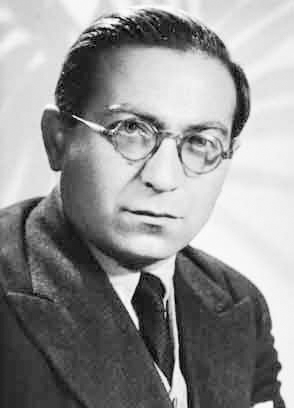
Odette Rosenstock Abadi (1914−1999) was born in Paris to a Jewish family that owned a garment factory. She and her sister grew up in relative comfort and in 1933, Odette entered medical school where, five years later, she obtained a physician’s license. (Her specialty was hygiene and the prevention of hygiene-related diseases.) During the 1930s, Odette became increasingly worried about the treatment of German Jews by Hitler and his Nazi party. She went south to the Pyrénées as a volunteer to rescue and assist Spanish refugees fleeing Spain and the Spanish Civil War. (click here to read the blog, Miss Mary: The Irish Oskar Schindler). Afterward, Odette returned to Paris where she became the medical inspector for the city’s children evacuation centers.
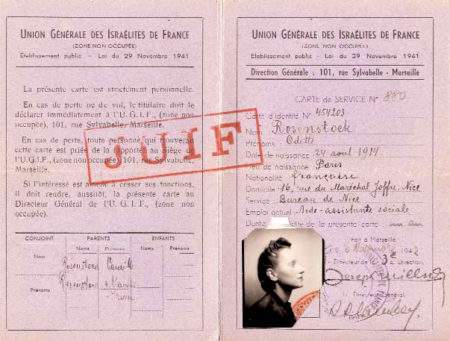
After the Nazis occupied Paris (and France), Vichy’s anti-Jewish laws forced Odette to resign her position. Her father, Camille (1882−1967) escaped to the south of France (i.e., the free, or unoccupied zone) while her mother, Marthe (1889−1943) and sister, Simone (1919−1943), remained in Paris. Marthe and Simone were arrested in 1943 and taken to the Drancy internment/transit camp outside Paris. On 2 September 1943, mother and daughter were loaded into one of the cattle cars of convoy no. 59. Taken to KZ Auschwitz II-Birkenau, they were murdered shortly upon arrival.
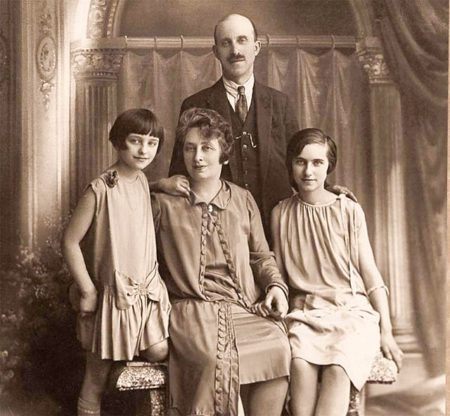
The Turning Point
In June 1940, Moussa relocated to Nice while Odette followed him in November 1941 where she joined l’Œuvre de Secours aux Enfants (OSE), or “Help the Children Fund.” Even though Nice was in the free, or unoccupied zone and a relatively safe location for Jews, Moussa became increasingly worried about his safety and that of other Jews.
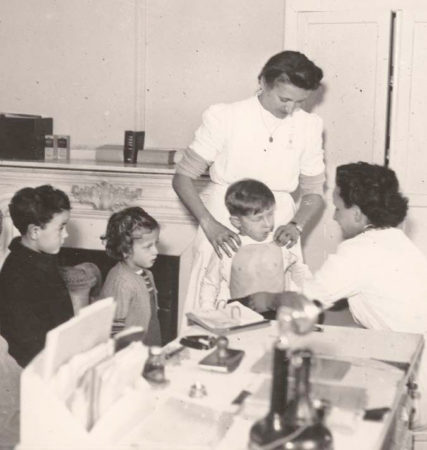
The defining moment for Moussa came one morning in April 1942 when he was taking a walk on the Promenade des Anglais running parallel to the beach at Nice. A young woman lay on the ground as a French policeman stomped on her head with his heavy boots. Twenty people, including her six-year-old son, gathered around to watch. No one assisted the dying woman as her son yelled, “Mama, Mama, Mama.” Moussa asked, “What’s happening?” A man nearby answered, “Can’t you see? He’s disciplining a Jew.”
Moussa was shocked and over the next few days, he decided he and Odette had to take action. He believed time was running out to save the Jewish children.
By November 1941, Vichy was accelerating the arrests of Jews in the unoccupied zone with foreign-born Jews as the primary targets. Moussa was in danger. In August 1942, a mass roundup took place but by this time, Moussa and Odette had obtained false identification papers that substituted their Jewish surnames with Christian names. (Odette was known as Sylvie Delatre while Moussa became Monsieur Marcel.)
The Italians moved into the area encompassing Nice during November 1942. Mussolini was more tolerant of Jews than his German counterpart and the situation for Jews temporarily improved. Despite their efforts to stall the Nazis from deporting Jews, the Italians eventually lost ground after Hitler invaded the unoccupied zone. Even with false identities, Moussa and Odette’s clandestine activities eventually came to the attention of the Nazis.
Réseau Marcel
Moussa and Odette created réseau Marcel in 1943 (i.e., Marcel Network). Its mission was to save Jewish children from the gas chambers. During its existence, the network accepted children from parents afraid of the certain fate their children faced. The réseau Marcel was one of the least known resistance organizations but operated as one of the most successful rescue operations for Jewish children in Vichy France.
Moussa, Odette, and réseau Marcel are credited with saving 527 children. Only two out of the hundreds of children taken under their protection were arrested and perished.
Click here to watch a video on the Marcel Network.
The Priest and Pastors
Moussa and Odette could not have pulled off their amazing rescue operations without the assistance of hundreds of individuals. Key to the success of the network were several members of the clergy.
The bishop of Nice, Paul Rémond (1873−1963), was approached by Moussa and the bishop agreed to support Jewish children by sheltering them in his diocese. He also provided Moussa with an office in the church headquarters as well as providing staff assistance. Monsignor Rémond appointed Moussa as “general inspector of the diocese educational institutions.” This allowed Moussa to freely travel and visit potential shelters.
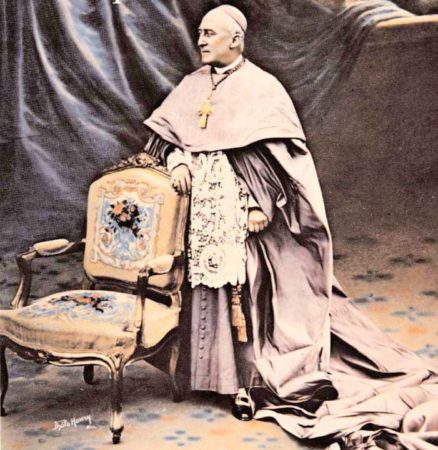
Most of the children were housed in the dormitories of Catholic schools as enrolled Catholic students. The children underwent “depersonalization” where they were taught to lose their Jewish identity and adopt a Gentile name, profile, and background. (For example, Myriam Bernstein became “Danielle Bernier.”) The pavilion at the Clarisses convent in Nice was used as “training” center for the children. Each child was required to remain at the convent and would not be released until they had mastered their lessons: new names, place of birth, names and fate of their parents, where their father worked, and every piece of their cover story. Moussa later described the “depersonalization” process as, “atrocious, odious, awful, for hour after hour.” One of the children, Jeannette Wolgust, remembered the process as being worse than Moussa’s description.
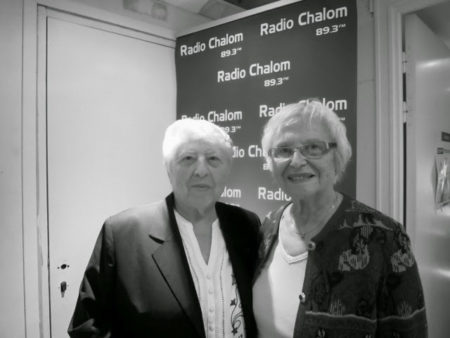
Evrard Edmond (1890−1981) was the pastor of the Baptist community in Nice. Pastor Edmond, his wife and two sons, worked closely with Jewish resistance groups. His sons served as guides for Jewish children on the escape route from Nice to Switzerland. While Moussa was recruiting the bishop, Odette approached Pastor Edmond who agreed to assist with réseau Marcel’s mission.
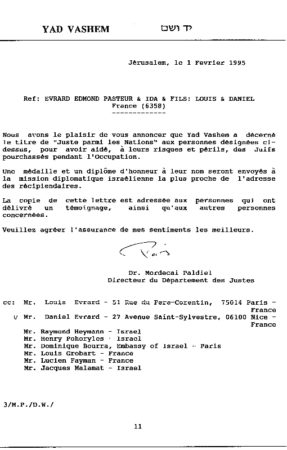
Pierre Gagnier (1909−1988) was pastor of the Reformed Church in Nice. He and his wife, Hélène, also assisted Odette. They provided forged identity papers, food coupons, illegal transfers, and anything else the rescue operation needed. Pastor Gagnier and Hélène were responsible for finding families who would accept and shelter Jewish children in their homes.
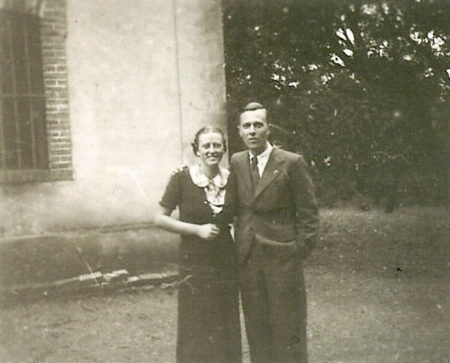
KZ Auschwitz II – Birkenau
Odette was arrested by several members of the French Milice (a Vichy paramilitary organization) on 25 April 1944 at her apartment at 6, rue Gounod, Nice. Moussa was at a meeting with another résistant. She was turned over to the Gestapo and taken to the Hotel Excelsior where she was slapped around and pushed. The next round of interrogation wasn’t so pleasant. Transferred to the Hotel Hermitage, Odette was subjected to “muscular” interrogations. (After the war, Odette never revealed what she meant by “muscular.”) Odette never divulged any information that would compromise the network, her colleagues, or the children. She was transferred from Nice to Drancy where her convoy train took her to KZ Auschwitz II-Birkenau. Upon arriving, Odette was chosen to work under Josef Mengele, the infamous Nazi doctor responsible for sorting the arriving deportees and known for his atrocious medical experiments on the inmates, principally, twins. Odette was later moved to KZ Bergen-Belson where she contracted typhus. The camp was liberated in April 1945 and Odette returned to Paris. Moussa was sent a note, “Odette is alive.”
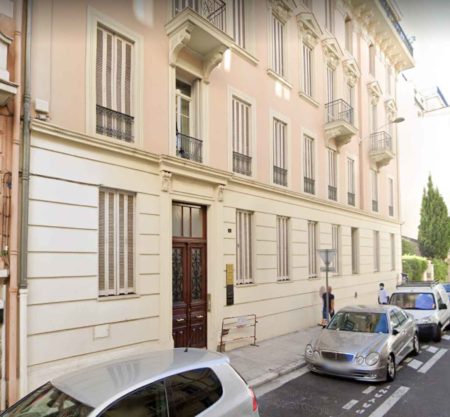
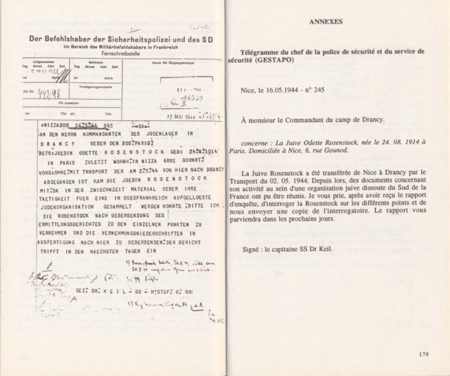
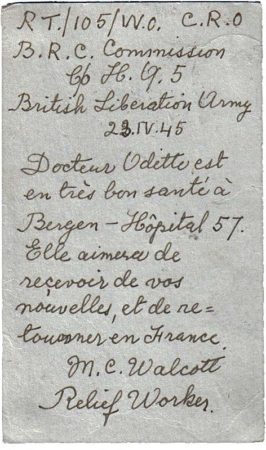
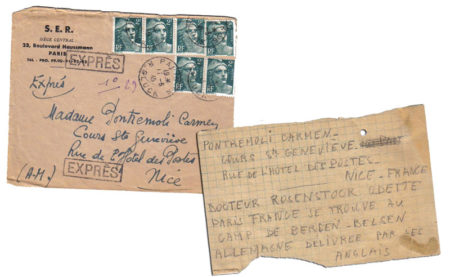
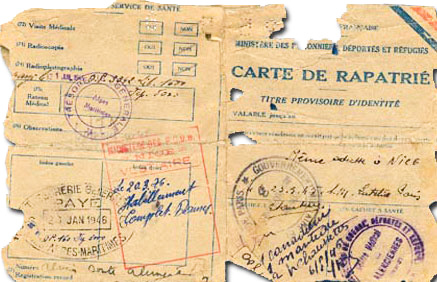
Postwar
Moussa and Odette were reunited in Nice but did not marry until 1959. They had a civil marriage ceremony in the 12th arrondissement town hall in Paris. Odette Abadi continued her work as a doctor while Moussa became a theater critic.
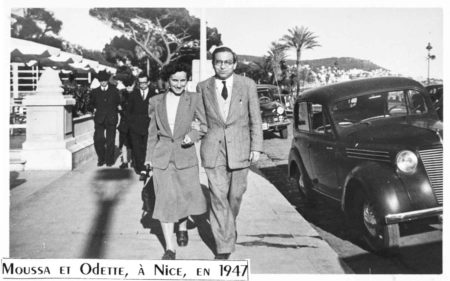
Yad Vashem honored Monsignor Paul Rémond, Pastor Edmond Evrard (and his wife and two sons), and Pastor Pierre Gagnier (and Hélène) as “Righteous Among the Nations.” Although identified for their resistance work, as Jews, Moussa and Odette were not eligible for the honor. Click here to watch an interview with Moussa and Odette.
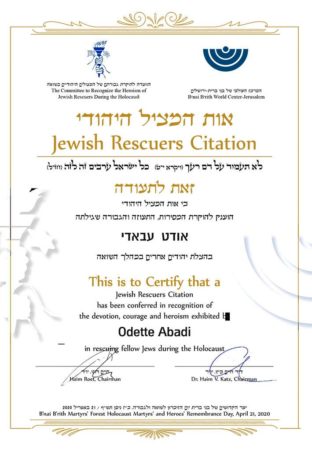
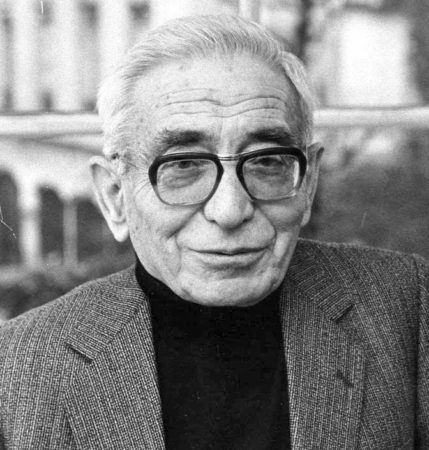
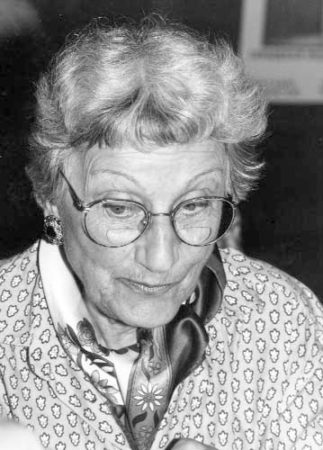
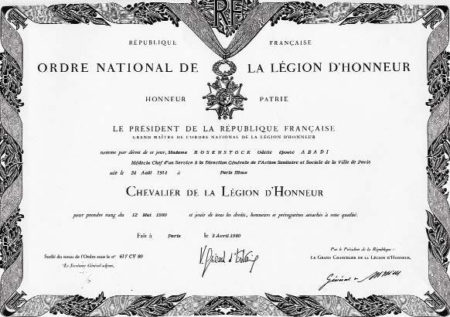
Moussa died in 1997 with only Odette at his side. She called the rabbi who performed her religious marriage to Moussa in 1989. He and his wife came to the hospital, made the necessary arrangements, and took Odette back to her apartment. Reluctantly, they left shortly afterward leaving Odette alone in the apartment she had shared with Moussa. Reaching the ground floor exit, they heard Odette screaming, “Moussa! Moussa, where are you!” For two years, Odette organized thousands of Moussa’s papers and planned her suicide. Odette’s suicide note left to her closest friends read in part, “In fact, I died at the same time as Moussa.” Odette and Moussa never had children of their own but after she passed, one of her obituaries called Odette, “The Mother of 527 Children.” The association, Les Enfants et Amis ABADI, was created in May 2000 by the children saved by Moussa and Odette. It honors the memory of Abadi, Rosenstock, the members of the réseau Marcel, and those who assisted.
Click here to visit the Les Enfants & Amis ABADI web-site.
A square, “Place Moussa et Odette Abadi,” in Paris is dedicated to the memory and as a tribute to Moussa and Odette’s resistance activities. A similar square, “Square Odette et Moussa Abadi,” was inaugurated in Nice.
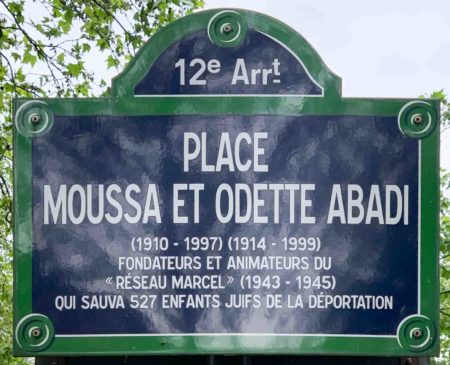
Moussa and Odette Abadi are buried together at the Montparnasse cemetery in Paris.
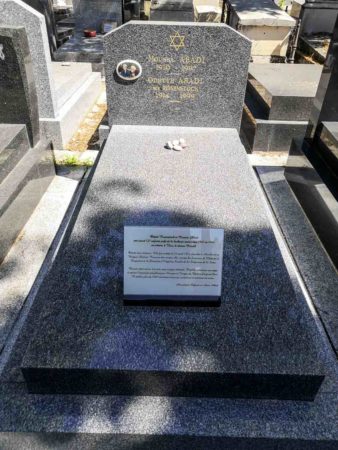
★ Learn More About The Marcel Network ★
My goal in writing these bi-weekly blogs is to introduce you to various people, stories, and history. Because of space limitations (and my attention span), I can only present you with a broad-brush narrative. If you enjoy this story and want to learn more, I can recommend the following reference sources.
Abadi, Odette. Terre de détresse: Birkenau – Bergen-Belson. Paris: Éditions l’Harmattan, 1995. (French language)
Coleman, Fred. The Marcel Network: How One French Couple Saved 527 Children from the Holocaust. Washington, D.C.: Potomac Books, 2013.
Jackson, Julian. France: The Dark Years 1940−1944. Oxford: Oxford University Press, 2001. (Pages 370 & 376)
Levendel, Isaac and Bernard Weisz (introduction by Serge Klarsfeld). Hunting Down the Jews: Vichy, the Nazis and Mafia Collaborators in Provence 1942-1944. New York: Enigma Books, 2011.
Poch-Karsenti, Andrée. Les 527 Enfants d’Odette et Moussa: Histoire du Réseau Marcel. Paris: Le Publieur, 2006.
Pollard, Miranda. A Question of Silence? Odette Rosenstock, Moussa Abadi, and the Réseau Marcel. “French Politics, Culture & Society,” Vol. 30, No. 2, Summer 2012. (Pages 113-133)
Odette and Moussa refused to discuss their wartime efforts to save the children. Mr. Coleman’s book is the first full narrative about their story. He pieced the story together by interviewing children saved by the couple, information from diaries, and interviews with friends of Moussa and Odette. It is not only the story of Odette and Moussa but also countless members of the Marcel Network including clergymen, nuns, families, messengers, and of course, the children.
Although Mr. Levendel and Mr. Weisz’s book is not about the Marcel Network, it takes place in the unoccupied zone and describes the efforts of the Nazis, the French police, and vicious French collaborationist organizations to arrest and deport Jews. It occurs during the same time that Moussa and Odette and réseau Marcel were saving children’s lives in and around Nice.
Odette’s book is an account of her experiences at Auschwitz and Bergen-Belson. Unfortunately, it has never been translated into English.
Disclaimer:
There may be a chance that after we publish this particular blog, the video links associated with the blog are no longer accessible. We have no control over this. Many times, whoever posts the video has done so without the consent of the video’s owner. In some cases, it is likely that the content is deemed unsuitable by YouTube. We apologize if you have tried to access the link and you don’t get the expected results. Same goes for internet links.
What’s New With Sandy and Stew?
Sandy and I would like to thank all of you who contacted us about purchasing a personalized autographed copy of the new book, Where Did They Put the Gestapo Headquarters? A Walking Tour of Nazi-Occupied Paris (1940-1944): The False War & Vichy (click here). I think between Amazon and direct sales, we sold more books in the first two weeks than all last year⏤not surprising. I’m very disappointed that the book is not available in France. It seems the French government is trying to protect their independent bookstores from Amazon (can’t say I blame them). So, getting books into France is impossible. Unfortunately, it seems our books are also not available on Amazon UK for our British friends. Sandy will be looking into this but considering Amazon’s posture with small vendors, we’re not very optimistic.
We are looking forward to publishing the second volume of the Gestapo book. Hopefully, it will be available by the end of this year or early in 2023. Its subtitle is “Roundups & Executions.” We’ve run into some unavoidable delays that may push the publication back.
Thank you to all of you who subscribe to our bi-weekly blogs. It seems there isn’t a day that goes by where we don’t increase our readership. Please let your history buff friends and family members know about our blog site and blogs.
Someone Is Commenting On Our Blogs
I’d like to thank several people for contacting us recently. First, thanks to Scott Selby for reaching out to us concerning our blog, The S-Bahn Serial Killer (click here for link). Scott is the author of A Serial Killer in Nazi Berlin (one of the books I highlighted in the recommended reading section of the blog). Thank you, Scott, for your kind comments regarding my feeble attempt to capsulize the story you told in greater detail. It seems the most activity we get on our blogs is when we feature a serial killer. So, guess what you all can expect in the future?
Also, a thank you to John B. for his nice comments regarding the blog, The SS City of Benares (click here to read the blog). John is a professor at Chapman University (our son graduated from Chapman) and is working with a team of filmmakers and researchers to produce a documentary on letters written during World War II. Unfortunately, I was not able to assist him with an introduction to Beryl Myatt’s relatives, but I did put him in contact with someone who has done quite a bit of research on the subject. Hopefully, that connection will pan out for John and his efforts.
Finally, thanks to Tom W. who contacted us about a guest blog we posted some time ago. Tom pointed out that the image of Adrienne used in the blog, Adrienne de Noailles: The Wife of Lafayette, was incorrect⏤my fault (click here to read the blog). He was kind enough to provide the correct image and we have since replaced the incorrect painting with Adrienne’s portrait. Tom knows his history about Lafayette and Adrienne and I appreciate him sharing his knowledge with me.
If there is a topic you’d like to see a blog written about, please don’t hesitate to contact me. I love hearing from you so keep those comments coming.
Why Would You Want to Buy Our Walking Through History Books?
Simple.
You like to travel and experience history and historical events. You like to see original buildings that had a significant impact on the people and events of the history you’re engaged with. You want to know the stories behind the brick and mortar in front of you.
The walking tour books are meticulously researched so you can go directly to those sites and learn about the building’s history as well as an introduction to some of the more interesting people associated with it.
We Need Your Help
Please tell your friends about our blog site and encourage them to visit and subscribe. Sandy and I are trying to increase our audience and we need your help through your friends and social media followers.
Thank You
Sandy and I appreciate you visiting with us. We have some exciting things on the horizon, and we’ll keep you updated as we go along.
Share This:
Follow Stew:
Find Stew’s books on Amazon and iBooks.
Please note that we do not and will not take compensation from individuals or companies mentioned or promoted in the blogs.
 Walks Through History
Walks Through History
Copyright © 2022 Stew Ross


I just saw your amazing work about the Réseau Marcel.
How did you get to know about it. Are you related to one of the children? My husband Julien Engel was one of the children hidden by Moussa and Odette. We live in Washington DC.
Hi Anne-Marie. Thank you so much for writing to us. I read Fred Coleman’s book, “The Marcel Network” and thought this might be a good story to share with our readers. It’s one of those stories that has gotten lost in the fog of history. I see your husband was one of the former children that Mr. Coleman interviewed for the book. I liked the two photographs with Julien and his brother George as well as the reunion with Odette and Moussa. Thank you again for sharing this information and making the connection. STEW